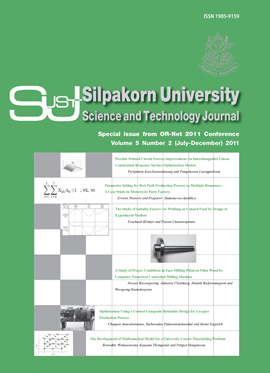Optimisation Using a Central Composite Rotatable Design for Lacquer Production Process
Main Article Content
Abstract
The objective of this research is to study the controllable factors affecting the lacquer quality and to find out the optimum conditions of the controllable factors by Central Composite Rotatable Design. For the crushing in Lacquer process, three controllable factors such as the quantity of solvent (x1), cooling temperature (x2), and the specific time frame of crushing (x3) were investigated. Response factor was the smoothness of lacquer surface. The relationship between response and controllable factors was determined. From the results, it was found that the optimal controllable factors were as followed: solvent of 95.59 kilograms, the cooling water temperature of 14.7 °C, and specific crushing time of 23.25 minutes. These controllable factors led to obtain the optimum smoothness of lacquer surface of 6.5 Hexman. The validation of the experiment by using such optimum setting of controllable factors from the Central Composite Rotatable Design, resulted in the 4.6% error of the lacquer surface smoothness. Keywords : Optimization; Smoothness of lacquer surface; Central composite rotatable design; Lacquer production process
Downloads
Article Details
References
Draper, N. R. (1982). Center points in second-order response surface designs. Technometrics, 24: 127-133.
Montgomery, D. C. (1997). Design and Analysis of Experiments. New York: John Wiley & Sons.
Myers, R. H., and Montgomery, D. C. (1995). Response Surface Methodology: Process and Product: Optimization Using Designed Experiments, New York: John Wiley & Sons.
Wiesberg S. (1985). Applied Linear Regression. John Wiley & Sons, New York.

